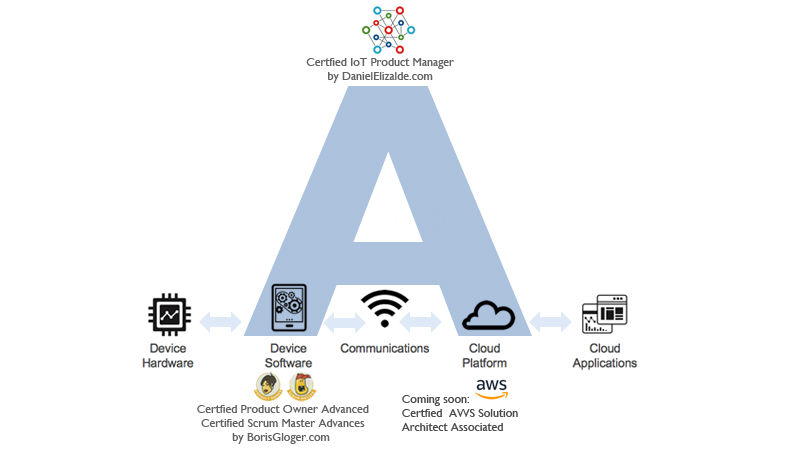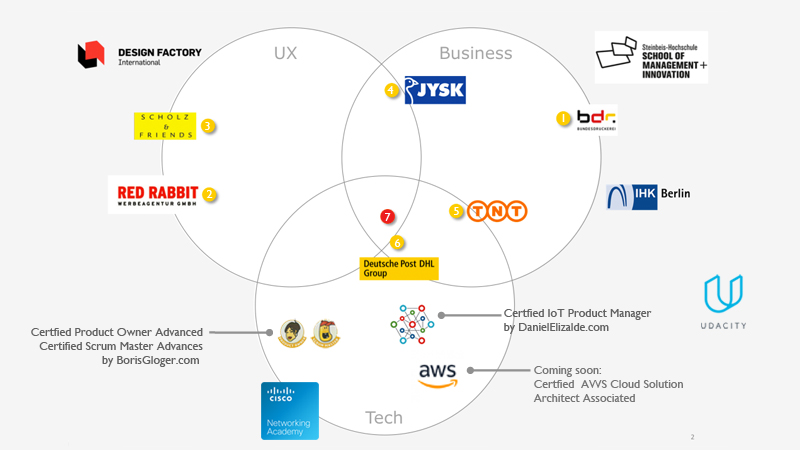„It’s still day one, to build next bridge to possible!“
Quote of Jeff Bezzos, combined with CISCO’s Claim = My Mission Statement.
Take your seat, get an overview of my mission and motivation. My story in a nutshell:
Next Level, after the Certified IoT Product Manager Course from Daniel Elizalde: Rethinking my Cases I realized, acquiring data from sensors and IoT is great, but to create most value from data, it’s essential to understand more Data Models, Native Cloud, AI and Machine Learning. My next milestone I focus is AWS Certified Solutions Architect – Associate.
SUMMARY
At the end customers love solutions to their problems. And I love solutions, build of new tech!
So it needs a team of cloud developers, cloud architects, product, maybe better solution managers and leadership attributes to guide the team with different domain expertise working together. Only UX, Business, Technology, Security, Soft Skills all in one bring a solution in a comprehensive way to the customers.
Special Thanks!
A special thanks to my coaches:
Daniel Elizalde/Santa Clara, Dave Higginson/Bonn, Julia Peters/Düsseldorf.
A special thanks as well to my co-workers:
Vivian Berni/Florida, Suraj Guha/Bonn and Nishi/Mumbai.
Deep Dive: All the good things are three!

1. Domain Knowledge, a cross-Industry point of view
2. Roadmap: From T- to A-Shape Approach
3. 3 Circles of PM and Leadership Pillar
1. Domain Knowledge

With TNT and DPDHL my industrial domain knowledge is Logistics Industry, transportation and sector industry knowledge. Sure thing!
But the Logistics Industry is a high connected industry with a lot of cross-industry approaches starting or ending with Logistics or Supply Chain and its business customers.
Logistic Industry
Logistics are build of networks. They include data-driven assets, like buildings, smart lockers, warehouses, containers, trucks, airplanes to mention a few. At the end different industries are working together to solve a business problem with todays technologies that means: Logistic Industry is a combination of Automotive, Aviation, Telecommunications, New Energy, New Mobility, Smart Building, Insurance, to mention the most relevant.
My Case Studies 1-n you find at the menu above.
New Energy
Today we thing in different dimensions about a Fulfillment Center. To drive efficiency, you want to optimize the power consumption.
If you use for the local areas electro mobility to deliver your goods, you have to recharge the fleet. If the old battery is out of order, you can use it, e.g. in a second life, with 40% power for some additional energy consumption inside the warehouse, depot or hub.
Automotive
On the ground we use in general our fleet for transportation. So automotive and it’s telematics data is a relevant part for logistic industry!
Customers and our Operations Team require in real-time the state of the truck and the goods inside, so we need multiple-sensors like Roambee.com, based on AWS cloud infrastructure, to track different states globally, even in remote areas.
New Mobility
Following the path of disruption further on, New Mobility is part of logistics. That means share vehicles or loading space and use the data as a logistic data provider, is necessary to build new strategies like postmates.com or Uber.com do. Or delivery to a trunk of a car with a smart lock is an alternative way to build your value chain at the last mile.
Telecommunication
The services of Telecommunications is key for tracking Asset Management. But also for optimization of route planning or manage the fleet in the delivery areas in an optimized way. Inside the sorting process surveillance camera’s including AI-models are able to identify damaged goods and communicate via WiFi to the cloud to reduce the manual tasks of the staff or fulfillment robots. In a holistic view it’s only possible with connectivity powered by Telecommunication Industry! And if coverage of a net is low in your area, you can build an antenna on the roof of your warehouse, it costs 80 € and you can rent it back to the telecommunication provider, like Sigfox.com.
Smart Factory
Today Logistic industry is becoming further more part of the future automotive supply chain. Automotive Industry is forced to drive more standardization and faster time to market of new cars. That means the Logistic Industry is taking over processes they could handle in a more efficient way. The time of only “Just in time” is over! For that challenge a new risk management solution creates value, which enables businesses to turn supply chain disruption and global environmental and socio-political volatility into competitive advantage by providing them with a holistic, end-to-end view of their supply chains and real-time risk visibility. We call it: [YouTube Link] Resilience360.com
2. From T- to A-Shape Approach

Enrich your experise in your IoT stack of technology or comparable frameworks. Focus on your strength: 1.device, 2.device software, 3.communications, 4.cloud platform, 5.cloud application.
Following the T-Shape framework you have one focus area. Mine is software in different roles from Product Owner, Product Manager and Product Leader also to manage the line organization in an agile manner. Since 2018 I enriched my focus domain towards Native Cloud, based on AWS, supported by AWS Community and a lot of self-learning. So I have chosen to adopt from T- to A-shape approach, from one to two expertise: Software & Cloud! The holistic view is key and a strong team with different skill sets is great to leverage all challenges, one PM can’t solve on his own.
3. 3 Circles of PM & beyond

From Marty Cagan, and as well with Daniel Elizalde in our PM Slack group I know, all area’s of your playground a relevant! Security and soft skills are additional one’s! But UX, Business and Technology are the three circles!
UX
In my earlier period, when I joined the most creative Agency Industry in Hamburg, my key learning was:
Identify first the problem and find the solution or the benefit to show the value proposition in a radical way! Today we call it in software create the MVP and start with the user story of most ROI and most value for the customers.
Business
ROI is also key in a holistic view to the solution! Build, the right functional building blocks, beginning with the MVP, choose the right priority and right technology, like micro services in a serverless cloud architecture, instead of adding functions to the old on-prem infra-structure. Focus on the earliest possible sprint to gain Revenue and EBIT! There are some different opportunities in today’s business models. Maybe by opening API’s on the device software and/or cloud layer? Or your customers get access to your core services by using their device data and a recurring license model is possible.
Technology
On my road towards the area of technology I learned, to achieve a competitive advantage in your business use a data-driven approach in all levels of your company. The amount of data continues to increase strongly within a few years, so create elasticity and flexibility in your infrastructure, to scale and transform your business to next level is key! That means, it’s great for me to learn and know a lot of emerging technologies, coming from Software, moving to Hardware, IoT, Native Cloud and AI,… but don’t miss the next big transformation step in technologies beyond these is more essential!
Additional links:
– Common PM Problem Areas, Marty Cagan: https://bit.ly/2oV5hzd
– Dimensions Knowledge, Process & Individual Skills, Marty Cagan: https://bit.ly/335Vox6
– Four Pillars of Product Leadership, Daniel Elizalde: https://bit.ly/359GyHP